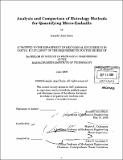| dc.contributor.advisor | Martin L. Culpepper. | en_US |
| dc.contributor.author | Doyle, Jennifer Ariel | en_US |
| dc.contributor.other | Massachusetts Institute of Technology. Dept. of Mechanical Engineering. | en_US |
| dc.date.accessioned | 2010-04-28T15:34:34Z | |
| dc.date.available | 2010-04-28T15:34:34Z | |
| dc.date.copyright | 2009 | en_US |
| dc.date.issued | 2009 | en_US |
| dc.identifier.uri | http://hdl.handle.net/1721.1/54451 | |
| dc.description | Thesis (S.B.)--Massachusetts Institute of Technology, Dept. of Mechanical Engineering, 2009. | en_US |
| dc.description | Cataloged from PDF version of thesis. | en_US |
| dc.description | Includes bibliographical references (p. 65). | en_US |
| dc.description.abstract | Micromilling is a powerful machining method increasingly used in the medical, optical, and electronics industries to rapidly create 3-dimensional, micro-scale components for meso-scale devices. The micromilling process causes higher incidences of tool wear and breakage, which are often not readily visible on micro-scaled tools. However, these tool defects must be accounted for if the process is to be made reliable. Size differences on the order of tens or hundreds of microns may be negligible in macroscale or "conventional" milling, but in micromilling it is not uncommon for the workpiece to be on the order of this size. As such, accurate, repeatable tool metrology is necessary for successful micromilling. This thesis presents a summary of four micro-tool metrology methods, relating qualitative measures such as ease of use, image quality, and tool throughput as well as the numerical validity of tool measurements obtained by the four methods. This was achieved by measuring the diameters of ten micro-endmills of five different sizes; each endmill was measured using all four measurement techniques. A Microlution 363-S series micromill, which uses a laser-occlusion measurement system to confirm tool geometry, was found to be simpler and faster than optical, digital, and scanning electron microscopy methods. Though laser occlusion lacks the visual information provided by microscopy, calculated Student t-test p-values for this method were greater than a set 0.1 significance level for every tool size. All three microscopy methods had p-values below the 0.1 significance level for some tool sizes, suggesting that the laser occlusion method provides the lowest statistical likelihood of variance in measured tool geometry due to measurement error. | en_US |
| dc.description.abstract | (cont.) Furthermore, all four measurement techniques were found to be more accurate when measuring smaller tools than when measuring larger tools; in particular, SEM measurements of large tools suggested a high probability of incorrect measurement. The findings presented here have the potential to foster further discussion and use of on-machine measurement systems in microscale metrology over the currently prevailing microscopy methods, in particular SEM. | en_US |
| dc.description.statementofresponsibility | by Jennifer Ariel Doyle | en_US |
| dc.format.extent | 65 p. | en_US |
| dc.language.iso | eng | en_US |
| dc.publisher | Massachusetts Institute of Technology | en_US |
| dc.rights | M.I.T. theses are protected by
copyright. They may be viewed from this source for any purpose, but
reproduction or distribution in any format is prohibited without written
permission. See provided URL for inquiries about permission. | en_US |
| dc.rights.uri | http://dspace.mit.edu/handle/1721.1/7582 | en_US |
| dc.subject | Mechanical Engineering. | en_US |
| dc.title | Analysis and comparison of metrology methods for quantifying micro-endmills | en_US |
| dc.title.alternative | Metrology methods for quantifying micro-endmills | en_US |
| dc.type | Thesis | en_US |
| dc.description.degree | S.B. | en_US |
| dc.contributor.department | Massachusetts Institute of Technology. Department of Mechanical Engineering | |
| dc.identifier.oclc | 551147762 | en_US |
